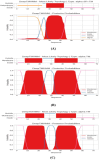Characterization of holins, the membrane proteins of coliphage ASEC2201: a genomewide in silico approach
- PMID: 40703241
- PMCID: PMC12283622
- DOI: 10.3389/fmicb.2025.1550594
Characterization of holins, the membrane proteins of coliphage ASEC2201: a genomewide in silico approach
Abstract
Drug-resistant Escherichia coli poses a significant healthcare burden, driving the search for novel antimicrobials. We have previously done the isolation and whole-genome sequencing of ASEC2201, a novel coliphage derived from multidrug-resistant clinical E. coli strains. Here, we report the identification and characterization of phage enzyme, holin by in silico approaches. Genome annotation using Prokka identified three putative holin genes (PROKKA_03659, PROKKA_04292, and PROKKA_04422) belonging to the Phage_holin_2_1 superfamily. Upstream promoter prediction revealed active regulatory elements at positions 112, 177, and 186 for these genes, indicating robust transcriptional activity. Transmembrane topology analysis using DeepTMHMM confirmed the presence of two to three α-helical membrane-spanning domains in each holin, essential for pore formation. Homology modeling with SWISS-MODEL yielded high-confidence three-dimensional structures characterized by conserved membrane-anchoring motifs, as supported by QMEAN and GMQE quality scores. In silico identification of cell-penetrating peptide motifs within the holin sequences suggests potential for enhanced intracellular delivery in CPP-fusion therapeutic constructs. Overall, our in-depth analysis elucidates the structural and functional properties of ASEC2201 holins, underscoring their biotechnological significance as scaffolds for developing novel antimicrobial strategies against MDR E. coli. It gives us an understanding on how the holins, with their inherent membrane-disrupting functions, can be explored in detail for future use as lysis modules in programmable bacterial systems, while their identified CPP motifs offer additional potential for engineering targeted therapeutic delivery vehicles. This study also demonstrates the potential of integrative in silico approaches in developing a comprehensive foundation for future experimental validation for proteins with no prior functional annotation.
Keywords: ASEC2201; bacteriophage; bacteriophage-encoded enzymes; functional annotation; holins; phage-mediated lysis; protein 3D structure; transmembrane domain.
Copyright © 2025 Saeed, Padmesh, Singh, Singh, Siddiqui, Sen, Hussain and Beg.
Conflict of interest statement
The authors declare that the research was conducted in the absence of any commercial or financial relationships that could be construed as a potential conflict of interest.
Figures







Similar articles
-
Falls prevention interventions for community-dwelling older adults: systematic review and meta-analysis of benefits, harms, and patient values and preferences.Syst Rev. 2024 Nov 26;13(1):289. doi: 10.1186/s13643-024-02681-3. Syst Rev. 2024. PMID: 39593159 Free PMC article.
-
Can a Liquid Biopsy Detect Circulating Tumor DNA With Low-passage Whole-genome Sequencing in Patients With a Sarcoma? A Pilot Evaluation.Clin Orthop Relat Res. 2025 Jan 1;483(1):39-48. doi: 10.1097/CORR.0000000000003161. Epub 2024 Jun 21. Clin Orthop Relat Res. 2025. PMID: 38905450
-
Interventions to reduce harm from continued tobacco use.Cochrane Database Syst Rev. 2016 Oct 13;10(10):CD005231. doi: 10.1002/14651858.CD005231.pub3. Cochrane Database Syst Rev. 2016. PMID: 27734465 Free PMC article.
-
The Black Book of Psychotropic Dosing and Monitoring.Psychopharmacol Bull. 2024 Jul 8;54(3):8-59. Psychopharmacol Bull. 2024. PMID: 38993656 Free PMC article. Review.
-
Systemic pharmacological treatments for chronic plaque psoriasis: a network meta-analysis.Cochrane Database Syst Rev. 2021 Apr 19;4(4):CD011535. doi: 10.1002/14651858.CD011535.pub4. Cochrane Database Syst Rev. 2021. Update in: Cochrane Database Syst Rev. 2022 May 23;5:CD011535. doi: 10.1002/14651858.CD011535.pub5. PMID: 33871055 Free PMC article. Updated.
References
-
- Abdelghafar A., El-Ganiny A., Shaker G., Askoura M. (2023). A novel lytic phage exhibiting a remarkable in vivo therapeutic potential and higher antibiofilm activity against Pseudomonas aeruginosa. Eur. J. Clin. Microbiol. Infect. Dis. 42, 1207–1234. doi: 10.1007/s10096-023-04649-y, PMID: - DOI - PMC - PubMed
-
- Ali A., Bandaranayake R. M., Cai Y., Davis D. A., Amano M., Li B., et al. (2020). Structure-based design of highly potent HIV-1 protease inhibitors containing new tricyclic ring P 2-ligands: design, synthesis, biological, and X-ray structural studies. J. Med. Chem. 63, 6847–6860. doi: 10.1021/acs.jmedchem.0c00202 - DOI - PMC - PubMed
-
- Bagińska N., Grygiel I., Orwat F., Harhala M. A., Jędrusiak A., Gębarowska E., et al. (2024). Stability study in selected conditions and biofilm-reducing activity of phages active against drug-resistant Acinetobacter baumannii. Sci. Rep. 14:4285. doi: 10.1038/s41598-024-54469-z, PMID: - DOI - PMC - PubMed
LinkOut - more resources
Full Text Sources

